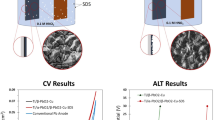Abstract
The electrochemical behavior of Bi2S3 coatings in Watts nickel plating electrolyte was investigated using the cyclic voltammetry, electrochemical quartz crystal microbalance, X-ray diffraction, and energy dispersive X-ray analysis methods. During the bismuth sulfide coating reduction in Watts background electrolyte in the potential region from −0.4 to −0.6 V, the Bi2S3 and Bi(III) oxygen compounds are reduced to metallic Bi, and the decrease in coating mass is related to the transfer of S2− ions from the electrode surface. When the bismuth sulfide coating is reduced in Watts nickel plating electrolyte, the observed increase in coating mass in the potential region −0.1 to −0.4 V is conditioned by Ni2+ ions reduction before the bulk deposition of Ni, initiated by Bi2S3. In this potential region, the reduction of Bi(III) oxygen compounds can occur. After the treatment of as-deposited bismuth sulfide coating in nickel plating electrolyte at E = −0.3 V, the sheet resistance of the layer decreases from 1013 to 500–700 Ω cm. A metal-rich mixed sulfide Ni3Bi2S2–parkerite is obtained when as-deposited bismuth sulfide coating is treated in Watts nickel plating electrolyte at a potential close to the equilibrium potential of the Ni/Ni2+ system and then annealed at temperatures higher than 120 °C.










Similar content being viewed by others
References
Mai TT, Schultze JW, Staikov G (2004) J Solid State Electrochem 8:201 doi:10.1007/s10008-003-0426-4
Vinkyavichyus I, Mozhginskene I, Zhelene A, Pilite S (1997) Russ J Appl Chem 70:1900
Mai TT, Schultze JW, Staikov G, Muňoz AG (2005) Thin Solid Films 488:321 doi:10.1016/j.tsf.2005.04.069
Valiulienė G, Žielienė A, Jasulaitienė V (2005) Chemija 16(2):18
Naruškevičius L, Šimkūnaitė B, Valiulienė G, Žielienė A, Jasulaitienė V, Sudavičius A, Baranauskas M, Stankevičius A (2007) Trans IMF 85(4):207
Abd El Halim AM, Fiechter S, Tributsch H (2002) Electrochim Acta 47:2615 doi:10.1016/S0013-4686(02)00122-6
Baranauskas M (2001) Pat. EP 1174530(A2) EU, Cl. C25D5/54. Method of placing conductor layer on dielectric surface
Valiulienė G, Žielienė A, Jasulaitienė V, Naruškevičius L, Pakštas V (2008) Trans IMF 86(6):326
Sauerbrey G (1959) Z Phys 155:206 doi:10.1007/BF01337937
Buttry D, Ward M (1992) Chem Rev 92:1355 doi:10.1021/cr00014a006
Saloniemi H, Kemell M, Ritala M, Leskelä M (2000) J Electroanal Chem 482:139 doi:10.1016/S0022-0728(00)00038-3
Kemell M, Saloniemi H, Ritala M, Leskelä M (2000) Electrochim Acta 45:3737 doi:10.1016/S0013-4686(00)00450-3
Oblonsky LJ, Devine TM (1995) Corros Sci 37:17 doi:10.1016/0010-938X(94)00102-C
Melendres CA, Pankush M (1992) J Electroanal Chem 333(1–2):103 doi:10.1016/0022-0728(92)80384-G
Benje M, Eiermann M, Pittermann U, Weil KG (1986) J Phys Chem 90(5):435
Grubač Z, Metikoš-Hukovič M (1999) Electrochim Acta 44(25):4559 doi:10.1016/S0013-4686(99)00174-7
Bard AJ (ed) (1975) Encyclopedia of electrochemistry of the elements, vol. 3. Marcel Dekker, New York
Valiulienė G, Žielienė A, Jasulaitienė V (2006) Trans IMF 84(3):162
Valyulene G, Zhelene A, Jasulaitene V, Shimkunaite B (2007) Russ J Appl Chem 80:1322 doi:10.1134/S1070427207080113
Baranov AI, Olenev AV, Popovkin BA (2001) Russ Chem Bull 50:353
Sakamoto T, Wakeshima M, Hinatsu Y (2006) J Phys Condens Matter 18:4417 doi:10.1088/0953-8984/18/17/027
Qian G, Shao M, Tong Y, Ni Y (2005) J Cryst Growth 284:412 doi:10.1016/j.jcrysgro.2005.07.013
Acknowledgments
The authors gratefully acknowledge the support by the Lithuanian State Science and Studies Foundation Grant T-07161.
Author information
Authors and Affiliations
Corresponding author
Rights and permissions
About this article
Cite this article
Valiulienė, G., Žielienė, A., Šimkūnaitė, B. et al. Electrochemical modification of Bi2S3 coatings in a nickel plating electrolyte. J Solid State Electrochem 14, 203–212 (2010). https://doi.org/10.1007/s10008-009-0792-7
Received:
Revised:
Accepted:
Published:
Issue Date:
DOI: https://doi.org/10.1007/s10008-009-0792-7




